You’ve heard it a million times over the past year – from consumer purchasing habits to industry standards, the pandemic has drastically reshaped the retail landscape. Hence, adaptability is a must to not only survive, but thrive.
The age of the pandemic comes with a wide range of trends that are quickly increasing and evolving. While there are numerous trends to watch out for in 2021, here are five staple trends that may stay for the years to come.
5 BIGGEST RETAIL TRENDS FOR 2026
- Omnichannel retail
- Social media presence and advertising
- Personalised, data-driven customer journeys
- Direct-to-Consumer (DTC) practices
- Same day deliveries
1. OMNICHANNEL RETAIL
Over the past year, more and more retailers have begun to offer an omnichannel shopping experience for customers. One of the ways this can be done is by enabling customers to pay for products online, but pick them up in-store using click-and-collect services.
While the general pattern has been for offline retailers to move into the digital space, it can also be beneficial for online retailers to develop a brick-and-mortar presence. This helps provide a well-rounded shopping experience for customers.
2. SOCIAL MEDIA PRESENCE AND ADVERTISING
Gen Z consumers spend significantly more time consuming content online. And with many still operating under work-from-home conditions, this means that they’re expected to spend more time on social media than ever before.
Hence, social media advertising is becoming exceptionally useful. The significant advantages and Unique Selling Points can be well demonstrated in a manner more engaging than traditional media outlets.
Customer journeys are also shortened by social commerce because they can complete their purchases directly on the platform rather than being redirected to an online or brick-and-mortar store. This simplified purchase process makes it significantly easier to increase brand awareness and stand out among competitors.
3. PERSONALISED, DATA-DRIVEN CUSTOMER JOURNEYS
Many retail websites already suggest products based on previously viewed or purchased items. Personalisation can be further improved with AI technology to allow product suggestions to be updated in real-time based on customer needs, interests, or potential desires.
The entire customer base can then be divided into clusters with similar characteristics such as device, frequency of support requests, shopping cart value, and much more. This allows retailers to maximise personalisation throughout the customer journey on their website.
4. DIRECT-TO-CONSUMER (DTC) PRACTICES
Companies can offer their products directly to consumers using DTC channels, removing any need for third-party aids such as suppliers and distributors. The key benefits of a DTC structure include:
- Better control of your branding
- Higher margins
- Consumers prefer to buy directly from manufacturers
5. SAME DAY DELIVERIES
There is a high demand for doorstep deliveries when it comes to online retails. While shipping delays and supply chain issues are common challenges in today’s day and age, small businesses can outperform large-sized retailers by providing same day deliveries.
Local retailers are closer to their customers and can set up the necessary systems to deliver products to them more quickly, potentially leading to increased sales. This will also encourage people to join the #SupportLocal movement that’s trending on social media.
The pandemic has fiercely accelerated pre-existing digital market trends and developed new trends. With the advancement of technology being a key player in the retail industry, you can expect more digital-savvy trends to rise in the near future.
To thoroughly understand these trends and strategically apply them to your business, equip your team to be fit for the “New Normal” with our New Retail and Retail Management training program which covers the following areas:
- The impact of digital transformations
- Platforms that are thriving in this new era
- How to create growth-driven strategies
- How to design your own blueprint for success
Kickstart your journey today by reaching out to us here.
3,280 total views, 1 views today
